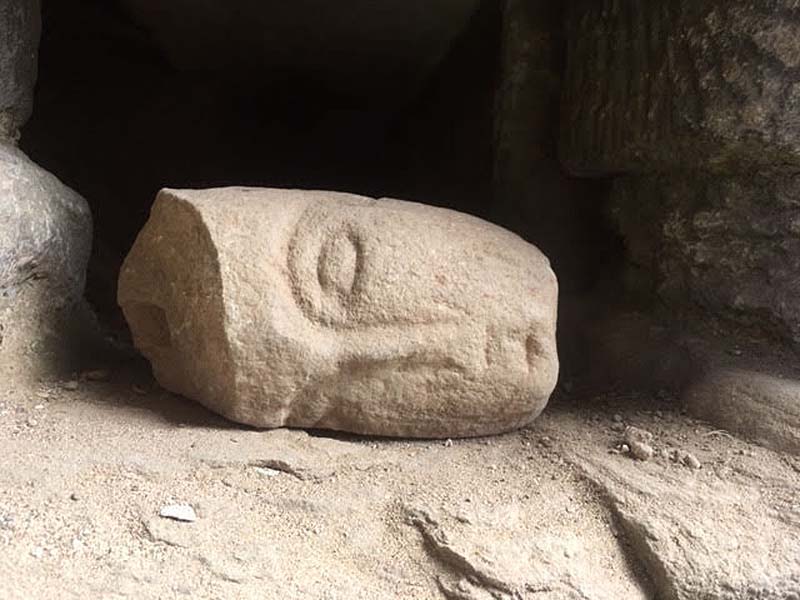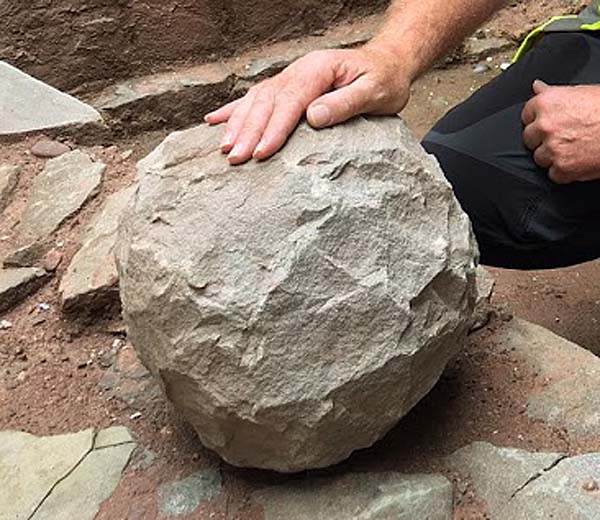Centuries-old Norman head and trebuchet ball found where they fell at Hay Castle
Another significant discovery was made by archeologists involved in the restoration of Hay Castle to include an intriguing collection of treasures
There have been remarkable and interesting finds made by Archaeologists who work on conserving one of the great medieval defense structures still standing on the border of Wales and England, Hay Castle.
Whilst investigating an area on the town side of the great gate of the Norman castle built in the late 12th century by the powerful Norman Lord William de Braose, archaeologists Peter Dorling and Dai Williams found an interesting stone embedded in the ground. When Peter extracted it and turned it over he was astonished to see a face staring back at him.
On closer inspection, the very early carving looks like a Norman soldier and has obviously suffered much damage over the years.
The lines of the carving have been worn away either by weather or by the stone having been buried and initial research and consultation indicate that this could indeed be an 11th or 12th-century carving. It may once have formed a decorative section of a window arch in the original medieval castle.
Describing the find as ‘intriguing and interesting’ Richard Suggett of the Royal Commission on the Ancient and Historical Monuments of Wales says, “you occasionally get carved heads set over doorways in houses and this may have been one. Perhaps there was a whole series of mounted heads at the ringwork. The imagination runs riot.”

The head’s decapitation could have occurred at several points in the castle’s long and turbulent history. Sacked by Llywelyn II, the last prince of Wales, in 1233, the castle was rebuilt under the custody of Henry III but centuries of turmoil followed until the 15th century when the castle passed into the hands of the Beaufort Estates.
The stone head joins an intriguing discovery made by archaeologists excavating in the derelict section of the mansion over the summer months. Hidden below centuries of previous floor levels they found a large, roughly cut spherical stone. The item is approximately 30cm in diameter and weighs about 29kg. Initial thoughts are that it could be a trebuchet ball.

Trebuchets are huge and complex catapulting siege weapons, among several different medieval siege weapons that were first used in Britain in around 1217.
The discovery raises tantalizing questions: was it fired at Hay Castle and found at its resting spot? Who might have fired it and when? There is little documentary evidence about attacks on Hay Castle but it could be possible that the trebuchet ball originates from the Barons’ War of 1263 to 1266.
The Patent Rolls of 1263, the administrative records recording the reign of Henry III, reveal that Prince Edward retaliated against the uprising Barons during the Second Barons’ War and when the town and castle of Radnor were destroyed Edward captured Hay.
“During this era of fighting across the Marches, Hay Castle passed from Bohun to Mortimer, to Simon de Montfort and back to the Mortimer family,” says Mari Fforde, who coordinates a lot of the historical activity on the site. “Maybe it was during these skirmishes that the trebuchet was used?
“Similar trebuchet balls were found at Dryslwyn Castle in Carmarthenshire. It is known from financial accounts that the siege of Dryslwyn in 1287 involved considerable cost in the construction of a counterweight trebuchet which threw balls weighing some 50kg.
This particular trebuchet was then transported to Cardigan, hauled by 40 oxen and 4 carts and escorted by about 500 soldiers. It is exciting to imagine the same scene happening in Hay at some point in the 13th century.”






